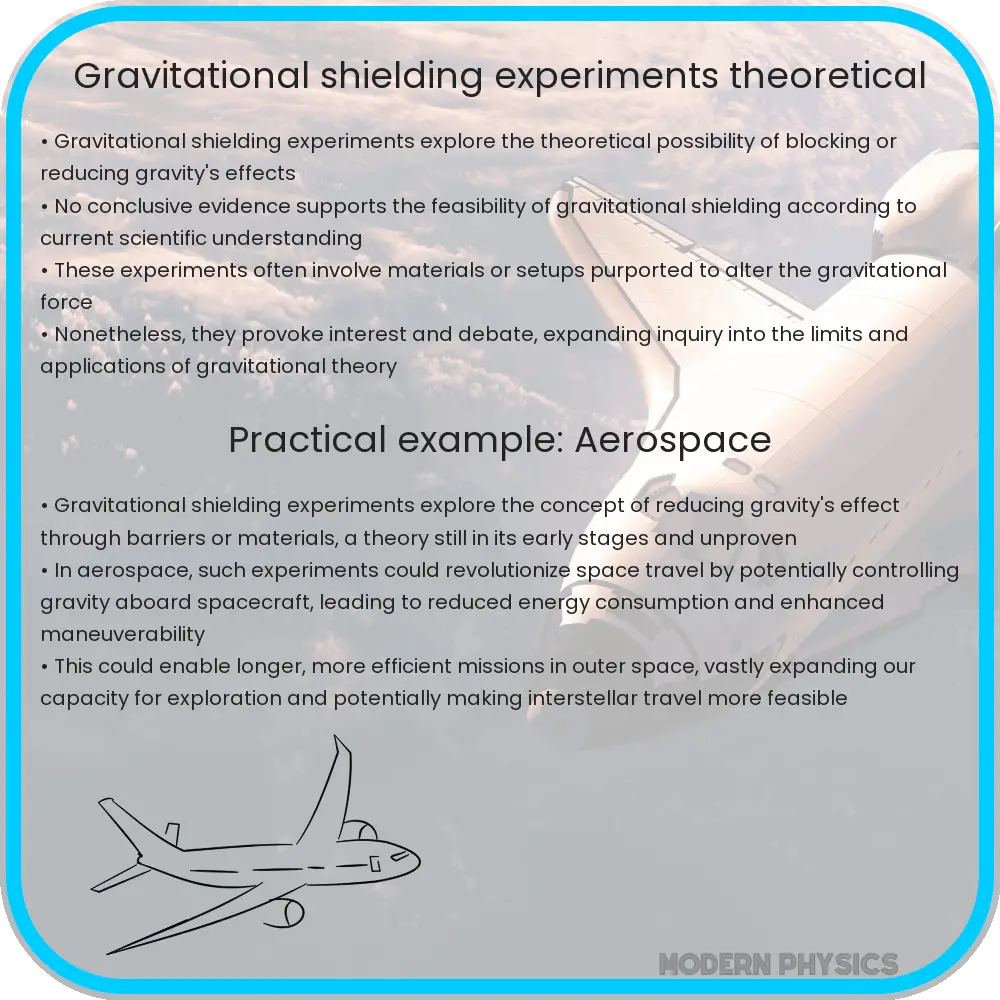Explore the intriguing concept of gravitational shielding, its theoretical challenges, experimental endeavors, and potential implications in physics.

Gravitational Shielding: Unraveling the Mystery
Gravitational shielding, a concept that teeters on the edge of contemporary scientific understanding, has long intrigued physicists and researchers alike. This theory posits the possibility of reducing or modifying the gravitational force in a localized region, akin to how electromagnetic shields mitigate electric or magnetic fields. Although it flirts with the realms of science fiction, recent experiments and theoretical advancements have sparked renewed interest and debate within the scientific community.
Theoretical Foundations
At its core, gravitational shielding would involve creating a “barrier” to the effects of gravity. This notion, however, directly challenges the established principles of Einstein’s General Theory of Relativity, which describes gravity not as a force but as a curvature of spacetime caused by mass. According to Einstein’s theory, mass tells spacetime how to curve, and spacetime tells mass how to move. Thus, the idea of shielding or blocking this curvature seems implausible under current physical laws.
Experimental Endeavors
Despite theoretical constraints, various experiments have been conducted to explore the feasibility of gravitational shielding. One notable experiment was led by Russian physicist Eugene Podkletnov in the 1990s. Podkletnov claimed to have observed a reduction in gravitational force above a superconducting disc when it was cooled below its critical temperature and spun at high speeds. Although his results garnered initial interest, they faced significant skepticism due to a lack of reproducibility and theoretical explanation.
The Debate Continues
The debate around gravitational shielding is fueled by a mix of scientific curiosity and skepticism. Proponents argue that exploration into such phenomena could lead to groundbreaking discoveries, potentially revolutionizing our understanding of gravity and spacetime. Critics, however, caution against pursuing seemingly unfeasible concepts, emphasizing the importance of empirical evidence and theoretical consistency in scientific research.
As gravitational shielding remains a topic of controversy, it serves as a reminder of the ever-evolving nature of science. New theories and discoveries often challenge existing paradigms, pushing the boundaries of what is considered possible. Whether gravitational shielding will ever move beyond the realm of theoretical speculation remains to be seen, but its investigation undeniably contributes to the dynamic landscape of modern physics.
Potential Implications and Applications
If gravitational shielding were to be proven viable, the implications would be profound and far-reaching. In space travel, for example, shielding technology could drastically reduce the effects of gravity, easing the energy demands for spacecraft launch and maneuvering. On Earth, it could lead to new methods for levitating objects, potentially revolutionizing transportation and structural engineering. However, these applications remain speculative and contingent on overcoming substantial scientific and technological hurdles.
Scientific Scrutiny and Future Research
The path to scientific acceptance of gravitational shielding, if it exists, is steep. For any claim to gain credibility, it must withstand rigorous scrutiny and be repeatable under controlled conditions. Future research in this area would likely delve into the realms of quantum physics and advanced material science. Studies might focus on understanding the interaction between gravity and other fundamental forces at a subatomic level, or exploring exotic states of matter like Bose-Einstein condensates, which could offer clues to new gravitational phenomena.
Integrating Theory with Experiment
For gravitational shielding to move from conjecture to reality, a theoretical framework that complements experimental findings is essential. This framework would need to not only explain any observed shielding effects but also fit seamlessly with the broader tapestry of physics, including relativity and quantum mechanics. The development of such a theory could lead to new insights into the nature of gravity itself, possibly even contributing to the elusive unified theory of physics.
Conclusion
Gravitational shielding remains a topic on the fringes of mainstream physics, teeming with intrigue and controversy. While current experiments and theories have not provided conclusive evidence of its existence, the pursuit of such knowledge is a testament to the relentless human quest to understand the universe. The debate over gravitational shielding underscores the importance of empirical evidence, theoretical rigor, and open-mindedness in scientific exploration. Whether it will ever transition from a speculative idea to a tangible reality is uncertain, but its investigation continues to provoke thought and inspire inquiry within the scientific community, reminding us that the mysteries of the universe are far from fully unraveled.
